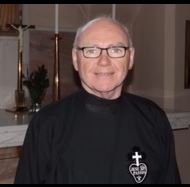On Wednesday of this week, the Feast of Saint Blaise, I left the Passionist house in Bishopbriggs to walk down to the post office in the village, where I had to get some documents weighed and posted. It was a miserable morning, wet and windy, but I felt the need to stretch my legs, having spent three nights on my younger brother’s couch over the weekend in a caring capacity, the need for which thankfully alleviated as the days progressed. About half way between the house and the village there is a post box on the Kirkintilloch Road. Peering through the rain, I saw a postman opening this box and shovelling the mail into his sack, before continuing on past me. It was then that I noticed, on top of the post box, a huge crocheted tammy with a bobble on top, containing a beautiful array of colours and a perfect fit for the post box. My first thought was to wonder what kind of mad person would crochet a tammy for a post box, but when I mentioned this to a friend, who has spent a good part of lockdown crocheting all kinds of amazing and beautiful things, she asked me if it had brought a smile to my face. I had to admit that it had and she said, “well, there you are”. She also made me aware of a phenomenon called yarn bombing, which is a kind of street art that employs colourful displays of crocheted yarn to decorate, not just post boxes, but also street lamps, benches, railings, and all kinds of things to brighten up dull, cold, urban environments. I have since come to learn that it is also known as wool bombing; yarn storming; guerrilla knitting; kniffiti; urban knitting and graffiti knitting. Technically, it’s probably illegal, but I can’t imagine that law being too rigidly enforced, especially as it is so easily removed.
It’s always good to come across things that can put a smile on your face, especially in difficult times, such as we are living in now, and I have a sneaking admiration for those who set out to do that, such as whoever first thought of putting a traffic cone on top of the Duke of Wellington’s head on the equestrian statue outside the Gallery of Modern Art in Queen Street. The statue has been there since 1844, and was already one of Glasgow’s iconic landmarks, but the traffic cone has now become a permanent feature, and a Glasgow tradition, representing our ironic local humour, and I imagine it’s there to stay, bringing a smile to most people’s faces whenever they pass it, including mine. Of course, there is a link between the Duke of Wellington and the Passionists. His nephew, Charles Packenham, was the first rector of Mount Argus in Dublin. He had more or less been disowned by his family when he converted to Catholicism in the wake of John Henry Newman’s conversion, who of course had been received into the Church by the Passionist priest, Dominic Barberi CP. Relations with his family were made worse when Charles announced his intention to join the Passionists, not the most illustrious or prestigious of Congregations, and the only one in the family to show him any support was his uncle, the Duke of Wellington, whose words of goodbye to him were, “Well, you have been a good soldier, Charles, strive to be a good monk”. Shortly afterwards, in May 1851, Charles entered the Passionist Novitiate at Broadway in Worcestershire, a village known as the Jewel of the Cotswolds, taking the religious name, Paul Mary. His famous uncle died the following year and, the now Father Paul Mary, himself died a few years later in Dublin, aged just 36, after a short illness, and is buried in the cemetery at Mount Argus. So, whenever you pass the equestrian statue of the Duke of Wellington in Queen Street, let the traffic cone bring a smile to your face, and, whatever else you may think about the man known as the Iron Duke, just remember his kindness and encouragement to his young nephew at a difficult time.
I’m not sure if any of you are crocheting during lockdown, or perhaps you are baking, painting, doing jigsaws, or engaging in some other form of creativity to keep you going. Here, we are mostly reading, walking, and preparing streamed liturgies and, of course, we have Father Gareth to continually keep a smile on our faces. We may hire him out. So, as ever, protect yourselves, protect your loved ones and others, and protect Christ in your lives.

 RSS Feed
RSS Feed
